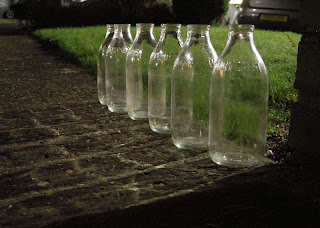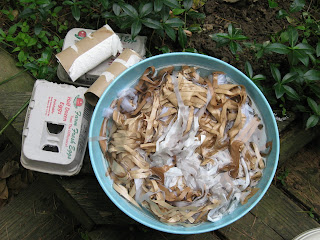 |
"10 01 2013 Lonely milkbottles"
by
Kikishua
is licensed |
Do you remember when everything came in glass bottles? Things like pop and ketchup and HP sauce. And milk! Apparently, so I've been told, there was a time when a milkman would deliver glass bottles of milk door-to-door. Dropping off the new full ones and picking up the old empty ones.
Oooh... and remember the Poppe-Shoppe? Where you'd bring your empty Poppe-Shoppe bottles back and then pick up full bottles? Well, strap on your seat-belt because the future is going to look a lot like the past in a few years.
In case you missed the memo, recycling plastic containers is not the solution. You've likely heard that China has stopped accepting all of our recycling containers, mostly cause a lot of them are contaminated with other stuff. You also may have heard that in a few decades, there will be more plastic in our oceans than fish. Which begs the question... where do our empty yogurt or laundry bottles go?? There are some rather alarming statistics about how much plastic we are sending off in the recycling stream. We think we are doing the right thing by tossing it all into our blue bin but... the truth is that in today's world, single-use anything has hit a brick wall. We can't keep living this way.
 |
| Rock Cycle (from Santa Fe College) |
The earth is NOT a single-use system where things are born, used, and then tossed away. The entire earth is a circular system... from the rock cycle (ejected out of a volcano as molten lava, solidifies as rock, gets eroded into sand, cemented into new rock, etc, etc, until it finally gets remelted into lava) to the carbon cycle (we've heard a lot about that) and the water cycle (ocean, evaporation, rain/snow, streams, lakes, rivers, oceans, etc.). And let's not even talk about the biological cycle... we are born, eat all sorts of things that come from the earth (plants, animals, mushrooms) and then, when we die... we go back to the earth, which will feed more plants and animals...
Plastics are most definitely not a circular system. Oh yes, some plastics can get recycled and turned into new plastics but a lot of them are given new life farther down the plastics food chain. Food-grade plastic might get recycled into a park bench or a fleece jacket. Until, eventually, it runs out of lives (it only has one or two to begin with) and ends up in the garbage. Plastic is most definitely not infinitely recyclable.
Unlike stainless steel (and other metals), aluminum or glass which can be used, collected, melted down and reformed into new tins, pop cans or jars/bottles an infinite number of times. Glass is, after all, just quartz sand melted at high temperatures and cooled quickly. In many ways, very similar to a simple rock cycle. And it's similar with aluminum and stainless steel... which is nice to know.
 |
| The future is refillable (From LoopCanada site) |
The basic gist is this: you pay a deposit when you buy an item, say a bottle of ketchup. You use the bottle of ketchup and then bring it back to the store (or put it in the delivery bag) and either (a) get your deposit back (in case you don't want ketchup anymore) or (b) get another bottle of ketchup. And your original bottle gets cleaned and refilled with new ketchup for the next person. Loop has deposits on everything from ketchup bottles to laundry detergent containers to diapers and menstrual pads. Mind you... the deposit on a ketchup bottle might be $0.25 while the deposit on a diaper might be $47. That will keep a few diapers out of the landfill! And yes, they take back the used diapers and menstrual pads and recycle them via TerraCycle.
This is not a small thing. Kraft Heinz Canada commissioned a survey which found that 83 per cent of Canadians want less packaging on their groceries, and 78 per cent want grocery products with zero-waste packaging.
 |
| Some of the items for sale on the LoopCanada site |
Now, in Canada, the Loop service is just starting out in Toronto (only) and will also be online via the Loop Store. Loblaws will be selling some of their bestselling President's Choice products with Loop. And apparently they are also looking at developing a reusable cookie tin for its PC Decadent Chocolate Chip Cookies. I almost want to say... aren't "cookie tins" already a thing?? I think the trick here is actually getting the cookie tins back via Loop so that they can be cleaned and reused for more cookies... instead of ending up holding buttons in someone's sewing room... or loitering for months in the local thrift stores.
 |
| Chipits from the LoopCanada site |
Which brings me to this... not all of the Loop items are packaged in glass or aluminum. Some items come in stainless steel and some items still come in plastic containers. But the key is... those plastic containers are not being used once and then tossed in recycling. They are being collected and reused for the same product, like cat litter or laundry detergent or Chipits chocolate chips!
I don't know about you, but I would dearly welcome the day where we have less of that plastic bag packaging that houses everything from chocolate chips to walnuts to cheese to toilet paper. A LOT of our waste, when we start looking at it in more detail is packaging. And that is just sad.
It's nice to know that there are alternatives coming down the pipeline towards us. I would imagine that our first shot at Loop will come via their online store but... who knows, maybe Loblaws will start introducing the concept into their stores. That would be super cool.













